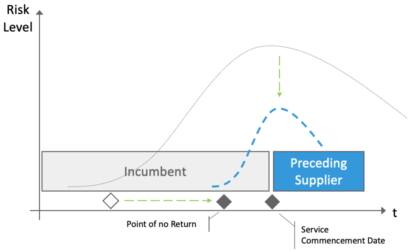Effective Risk Mitigation in Outsourcing Transitions
The transition of services from one service provider to a new provider is associated with considerable risks. Companies often enough experience a drop in service quality after the new provider has taken responsibility despite having considered all good practices such as careful planning of the transition, diligent review and acceptance processes for interim results or milestones, etc. Worst case, services were partially overlooked during the transition and result in a service continuity issue.
(I deliberately exclude the case of a “first generation sourcing” with a transfer of services directly from the company to a service provider in this article, since meanwhile only a few sourcing projects and thus transitions fall into this category any more.)
Typical risk situation
A typical risk curve during a transition follows roughly a bell curve as shown in figure 1 below as a blue line: the previous service provider (incumbent) continues to provide the services during the transition, the risks increase in the course of the project and often peak at the time of transfer of responsibility to the new service provider (Service Commencement Date).
Since there can be no perfect project planning that takes into account and takes up all the imponderables and unknowns, a different approach to risk mitigation and risk avoidance must be found.

In my experience, the central lever for risk reduction or, at best, risk avoidance lies in shifting the “point of no return”.
Shifting the “point of no return”
What do I mean by that? In every transition there is a point in time from which there is “no going back” to the previous service provider. Usually this is the date of termination of the old contract or the last option to extend services. If this point in time has passed, there is no longer any possibility of postponing the service commencement date. In the well-known triangle “quality, effort and time”, the dimension “time” is no longer variable. The “effort” dimension is usually not variable anyway, as transition projects are often agreed as fixed-price projects – consequently only the quality is subject to change. And this change often means a deterioration of quality.
In my consulting practice, I have made good experience with designing this point of no return as flexible as possible – at least shifting it as far as possible in the direction of the service commencement date. In figure 2, this shift is illustrated by a green arrow.

By making the “time” dimension variable, the quality can be stabilized while also the effort remains constant, and the risk curve can thus be significantly reduced (see second green arrow in the figure above).
Implementation in practice
Now, of course, the question arises as to how variability can be achieved in an interaction of complex and multi-year outsourcing contracts with different service providers.
Well: this cannot be achieved during the transition – upfront planning and preparatory work is necessary here:
One area of preparation affects the incumbent’s contract. Sufficiently flexible extension options have to be agreed here – well before the termination and re-tendering of the service. Not only must the option of a partial extension be agreed, but it must also be possible to invoke it at short notice (i.e. few months if not weeks prior to service commencement date).
The second area affects the contract with the new service provider. If an extension of the incumbent is necessary due to an underperformance of the new service provider during the transition, the resulting additional costs should understandably not be borne by the customer. Accordingly, suitable provisions must be included in the contract that allows the new service provider to be charged.
Conclusion
If both contracts are designed accordingly, you can extend the incumbent during the transition depending on the severity of deficits or the general risk level and thus avoid a possible service continuity issue.
The challenge, however, is to establish suitable, objective and in all aspects “bullet proof” criteria, on the basis of which the assessment of deficits and the triggering of the extension option are decided. I have covered this in more detail in another post.
At which point in the sourcing lifecycle is your company? Contact me and let’s talk about the value I can add in your situation.
 Deutsch
Deutsch